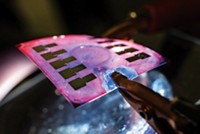Advertisement
Grab your lab coat. Let's get started
Welcome!
Welcome!
Create an account below to get 6 C&EN articles per month, receive newsletters and more - all free.
It seems this is your first time logging in online. Please enter the following information to continue.
As an ACS member you automatically get access to this site. All we need is few more details to create your reading experience.
Not you? Sign in with a different account.
Not you? Sign in with a different account.
ERROR 1
ERROR 1
ERROR 2
ERROR 2
ERROR 2
ERROR 2
ERROR 2
Password and Confirm password must match.
If you have an ACS member number, please enter it here so we can link this account to your membership. (optional)
ERROR 2
ACS values your privacy. By submitting your information, you are gaining access to C&EN and subscribing to our weekly newsletter. We use the information you provide to make your reading experience better, and we will never sell your data to third party members.
Materials
Monolayers Improve Organic Semiconductors
November 26, 2007
| A version of this story appeared in
Volume 85, Issue 48
Rutgers University physicists report that self-assembled organosilane monolayer films can increase the electrical conductivity of organic semiconductors by several orders of magnitude (Nat. Mater., DOI: 10.1038/nmat2059). The investigation may lead to new, simpler ways of converting organic materials—which are attractive due to their low cost but tend to be poor electrical conductors—into useful electronic components for displays, chemical sensors, and other applications. By coating crystals of the organic semiconductors rubrene and tetracene with thin films of heavily fluorinated silane compounds, Matthew F. Calhoun, Michael E. Gershenson, Vitaly Podzorov, and coworkers boost the crystals' conductivity by four to five orders of magnitude compared with uncoated crystals. Nonfluorinated compounds, such as n-octyltrichlorosilane, also increase conductivity, but the fluorinated monolayers give a more pronounced effect. The researchers also note that the presence of xylene, chlorobenzene, and other compounds leads to rapid and reversible changes in the coated crystals' conductivity, which suggests potential chemical-sensing applications.




Join the conversation
Contact the reporter
Submit a Letter to the Editor for publication
Engage with us on Twitter